Click on link below to view map of Nile Delta at night from Space
Nile Delta at Night As Seen From Orbit SpaceRef - Your Space Reference
Nile Delta at Night As Seen From Orbit
Source: NASA HQPosted Friday, October 29, 2010
From 220 miles above Earth, one of the Expedition 25 crew members on the International Space Station took this night time photo featuring the bright lights of Cairo and Alexandria, Egypt on the Mediterranean coast. The Nile River and its delta stand out clearly as well. On the horizon, the airglow of the atmosphere is seen across the Mediterranean. The Sinai Peninsula, at right, is outlined with lights highlighting the Gulf of Suez and Gulf of Aqaba. high res (2.2 M) low res (79 K)
Saturday, October 30, 2010
Sunday, October 3, 2010
History of the Nile
All great mysteries begin at the end and end at the very beginning. And for thousands of years, the Nile River was perhaps the world’s greatest mystery.
 Anyone can see where it ends, pouring northward through Egypt and into the Mediterranean Sea. But locating the origins of this magnificent river befuddled nearly everybody. Not until the Victorian Age did Western explorers find what had eluded so many.
Anyone can see where it ends, pouring northward through Egypt and into the Mediterranean Sea. But locating the origins of this magnificent river befuddled nearly everybody. Not until the Victorian Age did Western explorers find what had eluded so many.
The 19th century explorers who helped solve the mystery of the Nile's source were the best of the Victorian era, doing the work of Britain's Royal Geographic Society, of private sponsors, sultans, Egyptians and of a queen bent on expanding her empire.
But in settling the question of the Nile, the explorers may have inadvertently stumbled onto a whole new question: Just whose river is it?
That's still being debated and disputed among the countries of the Nile River Basin. But no one disputes the herculean efforts of the men and women who solved the puzzle.
River Of History
The likes of Dr. David Livingstone, Sir Richard Burton, John Hanning Speke, Samuel and Florence Baker, and Henry Morton Stanley still carry enormous weight among explorers, historians and adventurers.
But as is often the case in stories of heroism and hijinks, many of these people did great things, but not all of them were great people. Burton, for instance, reportedly loathed black people, an unfortunate prejudice given that the headwaters of the Nile are deep in the African interior.
Black Africans made up most of the expeditions that brought the explorers glory and fame. The Africans carried the water, the tools, the boats and sometimes even the explorers themselves. Many died along the way.
The explorers also managed to bribe and cajole warring African kingdoms to share information about where the headwaters of the mysterious Nile might be. Even Arab slave catchers contributed to the effort with valuable information and, in the case of Livingstone, life-saving supplies.
The work of the explorers was grueling -- and scary. In the mid-19th century, the Nile Basin was an unknown thicket to Westerners. Nearly every rocky, soggy, itchy step was on hostile ground. Creepy crawly insects, tsetse flies, bed bugs, mosquitoes and black ants the size of Chiclets were just as awful as the crocodiles along the shore and the pythons hanging from the trees.
But archaeologist Matthew Davies of the British Institute of East Africa says that the explorers had to press on.
"Particularly during the Victorian period it was seen that much of the basis of European civilization came from Egypt and had some kind of influence from Egypt," he says. "And so, I think it was bizarre to people in the Victorian period that their whole ancestry was based upon the Nile and yet the source of it was unknown."
The Victorians were looking specifically for the source of the White Nile, a major tributary of the river. Another major tributary called the Blue Nile originates in Ethiopia and meets the White Nile in Sudan en route to Egypt.
A River Discovered?
Edith Matega teaches high school history in Kampala, Uganda, near the headwaters of the White Nile. She says the Victorians were looking for something that wasn’t lost. Speke was the first white man to see Lake Victoria, a major source of the river. But Matega says he wasn’t the first person to see the lake.
“We don’t say, 'discovered,'��� Matega says. “Because we know the Africans had already seen it before him.”
Before the mid-19th century, Davies says, the job of following the Nile from beginning to end was too difficult for anyone -- European or African -- to tackle. The great missionary-explorer, Livingstone, died on his knees praying to understand the Nile’s flow.
But Samuel and Florence Baker found a major piece of the puzzle. They approached from Sudan, walking where they couldn’t sail, sailing where they couldn’t walk and moving forward where there was no going back. In 1864, they found not only where the Nile exits its major source at Lake Victoria, but also how it courses later through Lake Albert before heading north to Sudan and on to Egypt.
As the British say, the Bakers had “settled” the Nile. But nearly 150 years later, the Nile remains unsettled to many nations that depend on the river.
Two colonial-era agreements give Egypt and Sudan -- the downriver countries – the majority claim on the Nile’s waters. But other countries in the Nile Basin -- including Uganda, Tanzania, Kenya, Rwanda and Ethiopia -- now want to more equitably share the river.
Yet Egypt and Sudan say they won’t give up a single drop.
John Bosco Suuza, a lawyer for the Ugandan government, says, "Actually when you talk to Egyptians they jokingly -- although I'm sure seriously -- say, 'No, no, no, that's not your water. It's our water, stored in your country.'"

A hippopotamus wades into the waters of the Nile in Uganda.(Miguel Juarez for NPR)
The 19th century explorers who helped solve the mystery of the Nile's source were the best of the Victorian era, doing the work of Britain's Royal Geographic Society, of private sponsors, sultans, Egyptians and of a queen bent on expanding her empire.
But in settling the question of the Nile, the explorers may have inadvertently stumbled onto a whole new question: Just whose river is it?
That's still being debated and disputed among the countries of the Nile River Basin. But no one disputes the herculean efforts of the men and women who solved the puzzle.
River Of History
The likes of Dr. David Livingstone, Sir Richard Burton, John Hanning Speke, Samuel and Florence Baker, and Henry Morton Stanley still carry enormous weight among explorers, historians and adventurers.
But as is often the case in stories of heroism and hijinks, many of these people did great things, but not all of them were great people. Burton, for instance, reportedly loathed black people, an unfortunate prejudice given that the headwaters of the Nile are deep in the African interior.
Black Africans made up most of the expeditions that brought the explorers glory and fame. The Africans carried the water, the tools, the boats and sometimes even the explorers themselves. Many died along the way.
The explorers also managed to bribe and cajole warring African kingdoms to share information about where the headwaters of the mysterious Nile might be. Even Arab slave catchers contributed to the effort with valuable information and, in the case of Livingstone, life-saving supplies.
The work of the explorers was grueling -- and scary. In the mid-19th century, the Nile Basin was an unknown thicket to Westerners. Nearly every rocky, soggy, itchy step was on hostile ground. Creepy crawly insects, tsetse flies, bed bugs, mosquitoes and black ants the size of Chiclets were just as awful as the crocodiles along the shore and the pythons hanging from the trees.
But archaeologist Matthew Davies of the British Institute of East Africa says that the explorers had to press on.
"Particularly during the Victorian period it was seen that much of the basis of European civilization came from Egypt and had some kind of influence from Egypt," he says. "And so, I think it was bizarre to people in the Victorian period that their whole ancestry was based upon the Nile and yet the source of it was unknown."
The Victorians were looking specifically for the source of the White Nile, a major tributary of the river. Another major tributary called the Blue Nile originates in Ethiopia and meets the White Nile in Sudan en route to Egypt.
A River Discovered?
Edith Matega teaches high school history in Kampala, Uganda, near the headwaters of the White Nile. She says the Victorians were looking for something that wasn’t lost. Speke was the first white man to see Lake Victoria, a major source of the river. But Matega says he wasn’t the first person to see the lake.
“We don’t say, 'discovered,'��� Matega says. “Because we know the Africans had already seen it before him.”
Before the mid-19th century, Davies says, the job of following the Nile from beginning to end was too difficult for anyone -- European or African -- to tackle. The great missionary-explorer, Livingstone, died on his knees praying to understand the Nile’s flow.
But Samuel and Florence Baker found a major piece of the puzzle. They approached from Sudan, walking where they couldn’t sail, sailing where they couldn’t walk and moving forward where there was no going back. In 1864, they found not only where the Nile exits its major source at Lake Victoria, but also how it courses later through Lake Albert before heading north to Sudan and on to Egypt.
As the British say, the Bakers had “settled” the Nile. But nearly 150 years later, the Nile remains unsettled to many nations that depend on the river.
Two colonial-era agreements give Egypt and Sudan -- the downriver countries – the majority claim on the Nile’s waters. But other countries in the Nile Basin -- including Uganda, Tanzania, Kenya, Rwanda and Ethiopia -- now want to more equitably share the river.
Yet Egypt and Sudan say they won’t give up a single drop.
John Bosco Suuza, a lawyer for the Ugandan government, says, "Actually when you talk to Egyptians they jokingly -- although I'm sure seriously -- say, 'No, no, no, that's not your water. It's our water, stored in your country.'"
Saturday, September 25, 2010
Cairo, Sharia al-Muizz li-din Allah Street
This is perhaps the most impressive of all the buildings on the Sharia al-Muizz li-din Allah street in Cairo. This building is actually a building of two half’s, divided by a very long corridor. There is a madrasa, a mosque, a mausoleum and a khanqah for sufi’s in this one building. Absolutely beautiful and very imposing indeed. This building was made hundreds of years back by Sultan Barquq, and is quite similar to the other ones along the left hand side of this street.
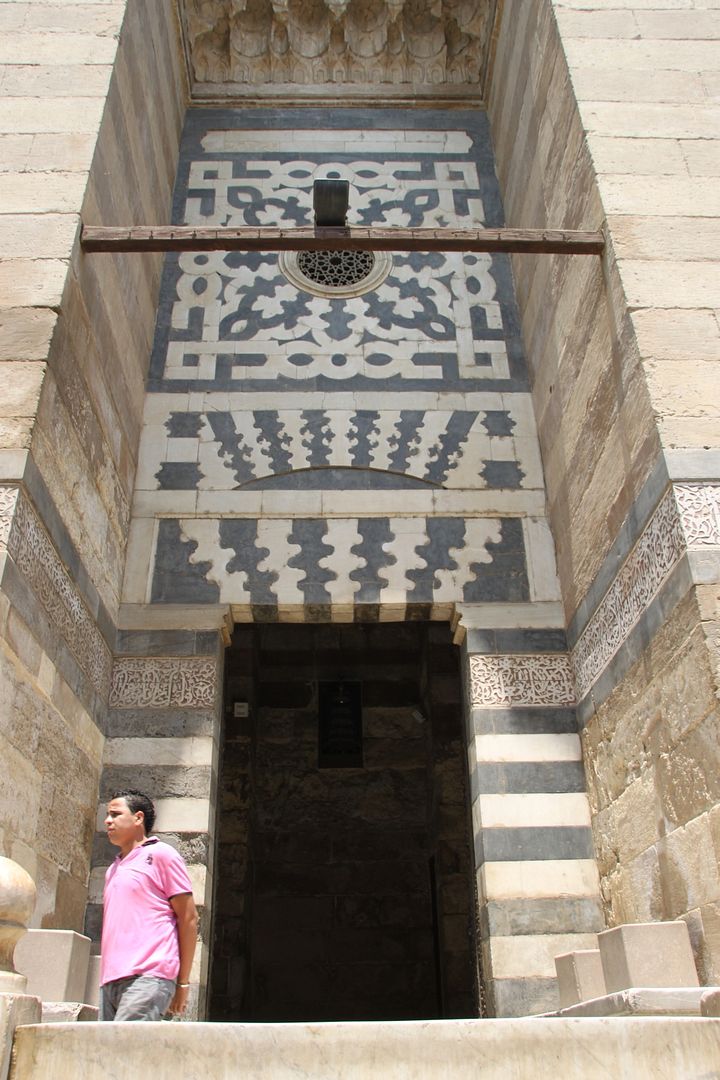
A reasonably un-prepossessing building entrance, the first time on this street that i have seen this kind of striped stone work which is not just simple plain stripes, but nicely carved in complex shapes.

The minaret is imposing, octagonal in construction with lovely cute little spiral carved pillars. There are three balconies with exquisitely carved railings.
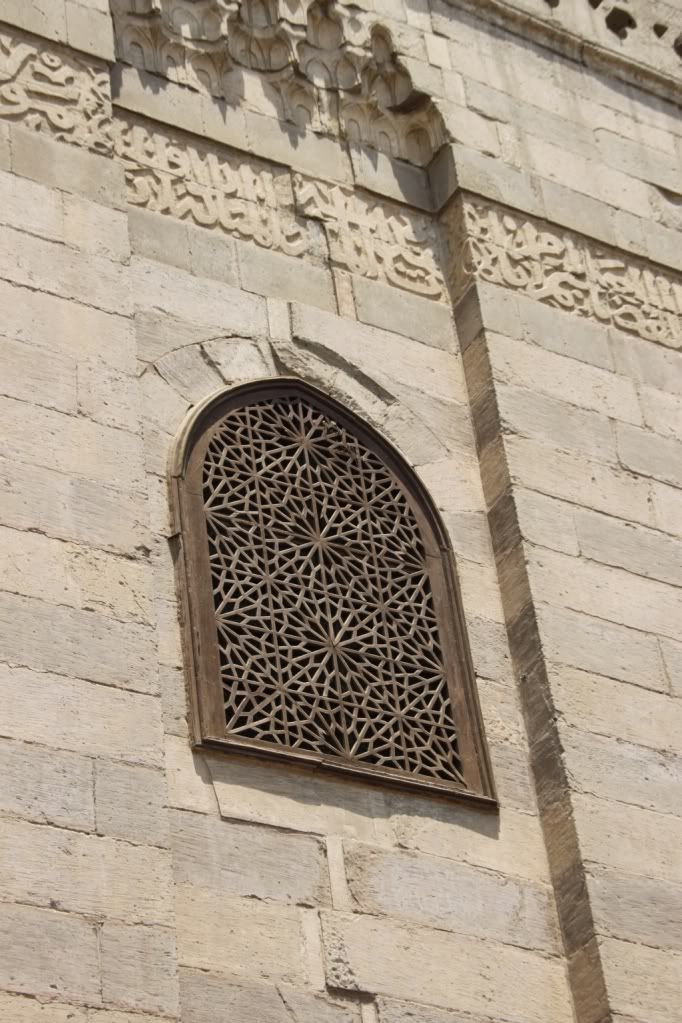
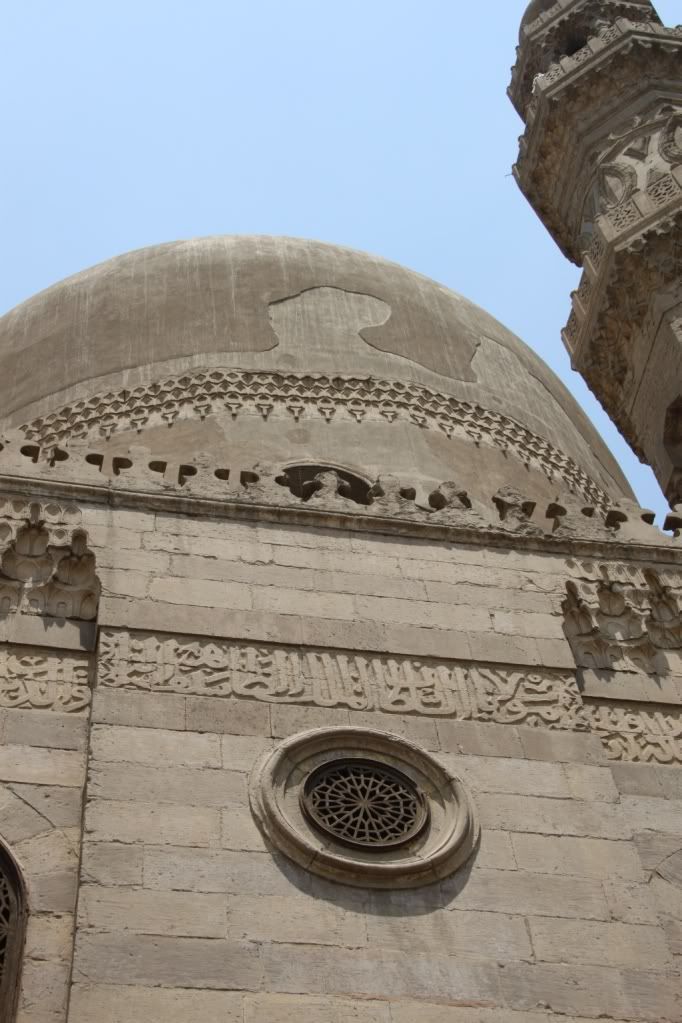

The facade is unusually severe but has these windows high up. Interestingly enough, the windows are of stained coloured glass, but more of that later.
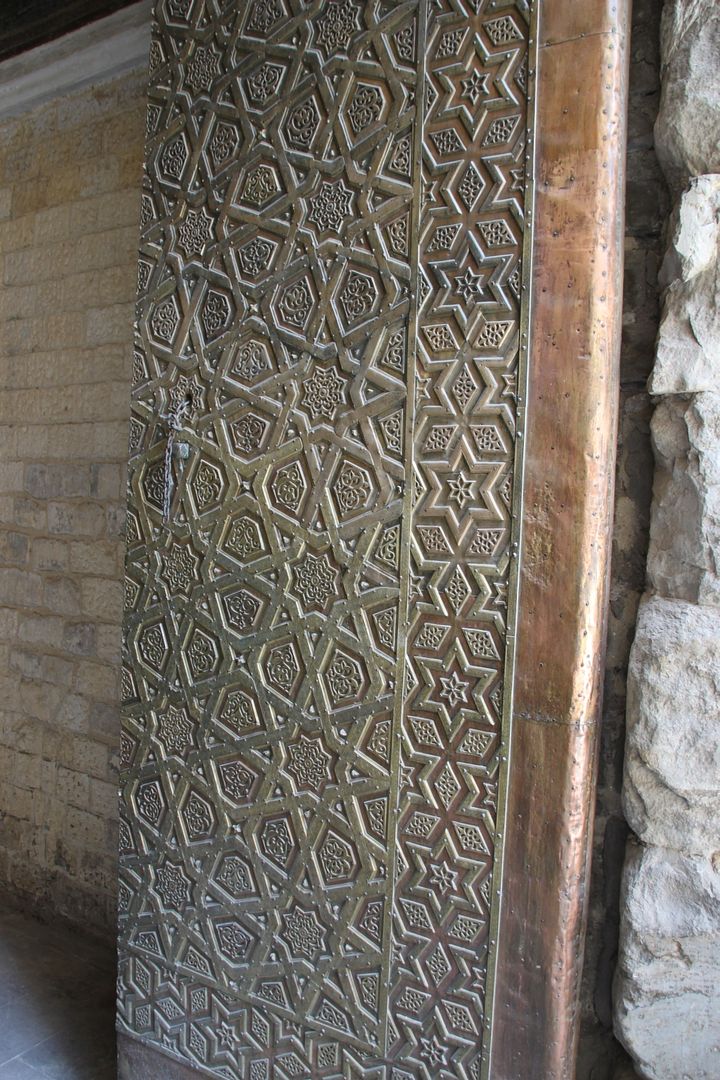
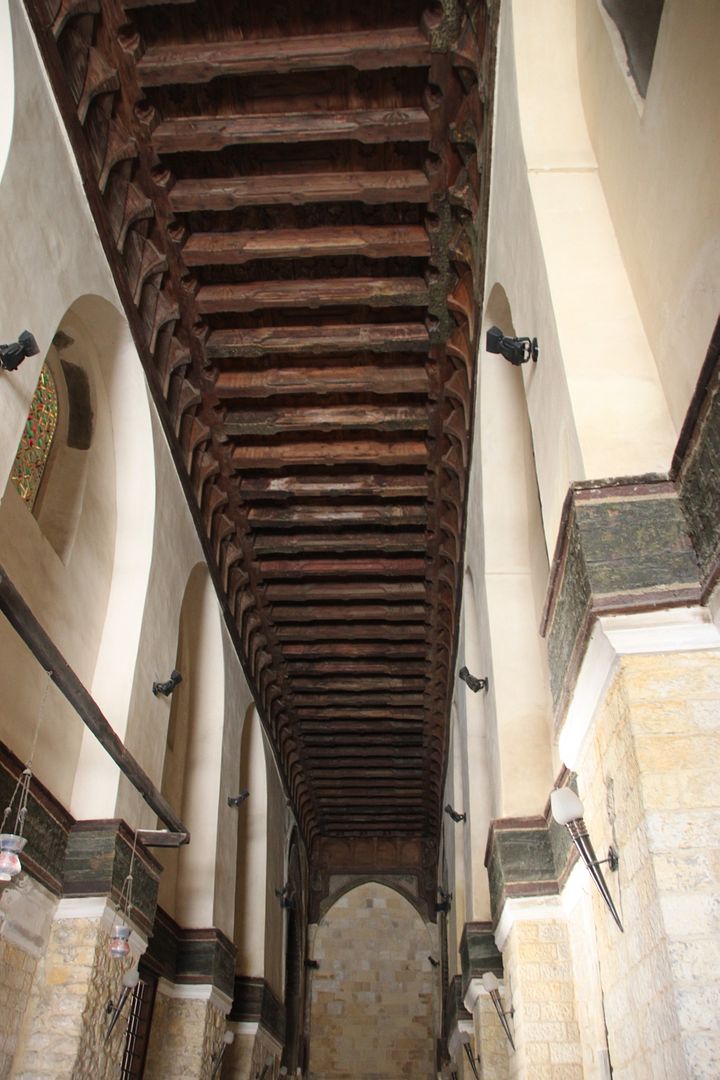
Very tall open bronze doors with geometrically designs on them. There is a very long corridor with a fascinating ceiling with lovely dark ancient wooden beams.
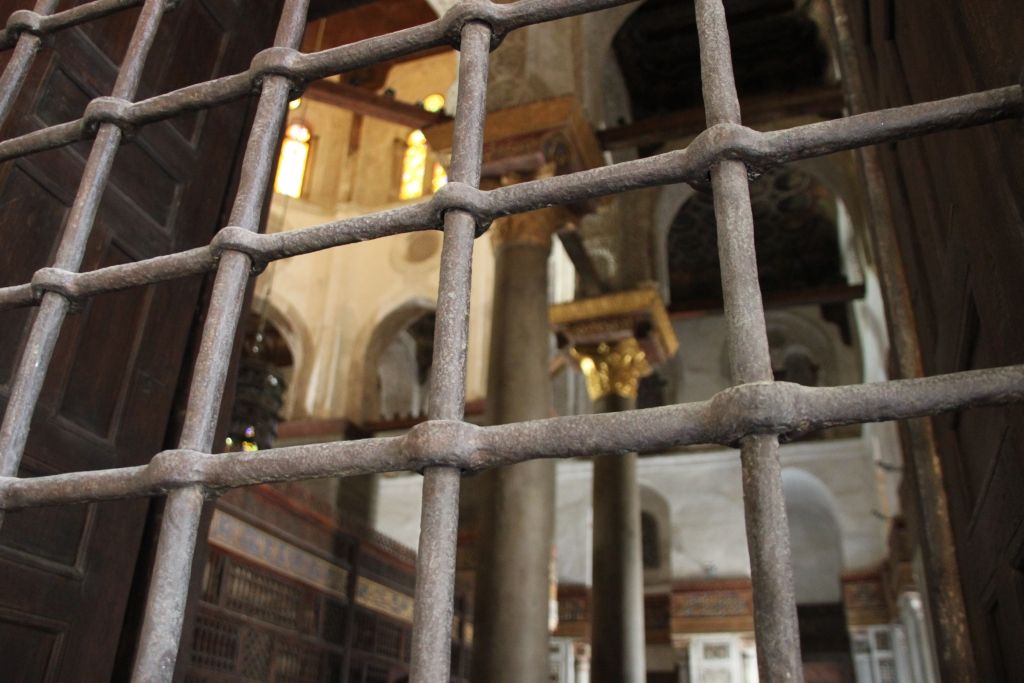
The corridor divides the complex into two, on the right, you can peek through heavily barred windows into the mausoleum.

The mausoleum is an extraordinary building. It is much higher than its width, which gives a very very strange outlook when you walk in. Plus to complicate matters even more, it has huge thick pillars. And then on top of it, the entire inside of the mausoleum is very richly decorated in vertical and horizontal stripes as we will see, which makes the building look even taller.
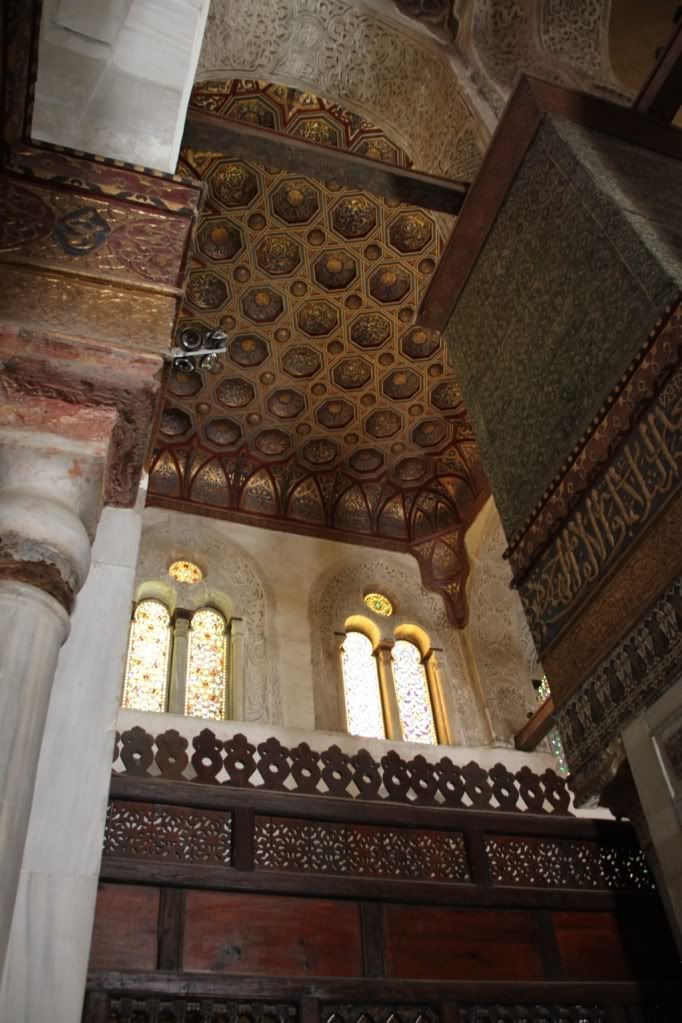
The ceiling is very richly decorated. With octagonal recesses, gilded. I am sure when this was lit by lamp lights and candles, it would be a magical place.
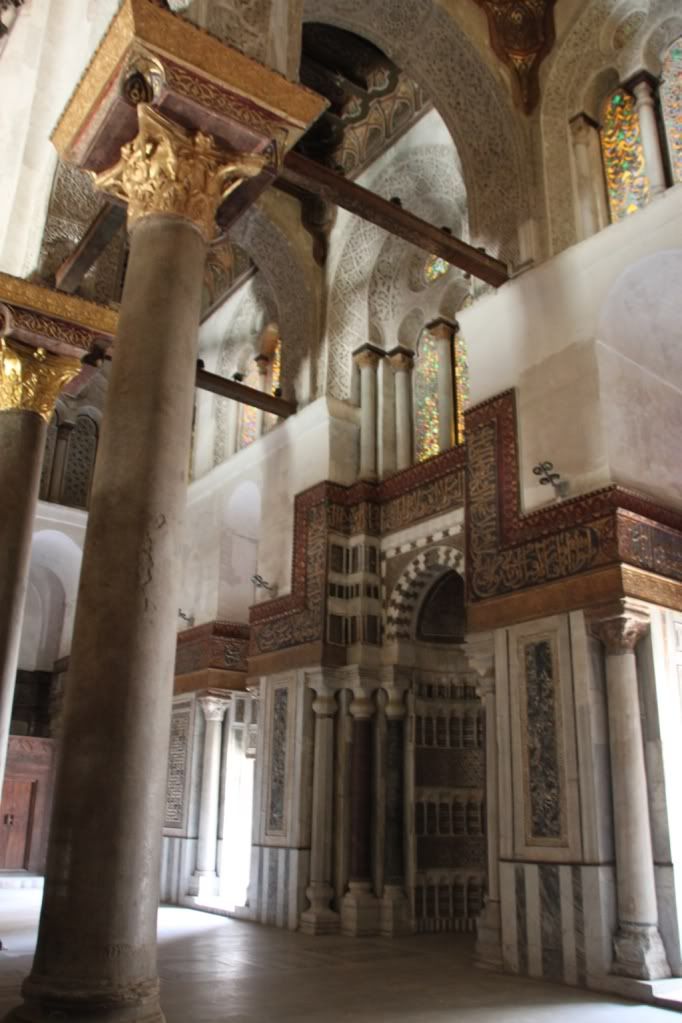
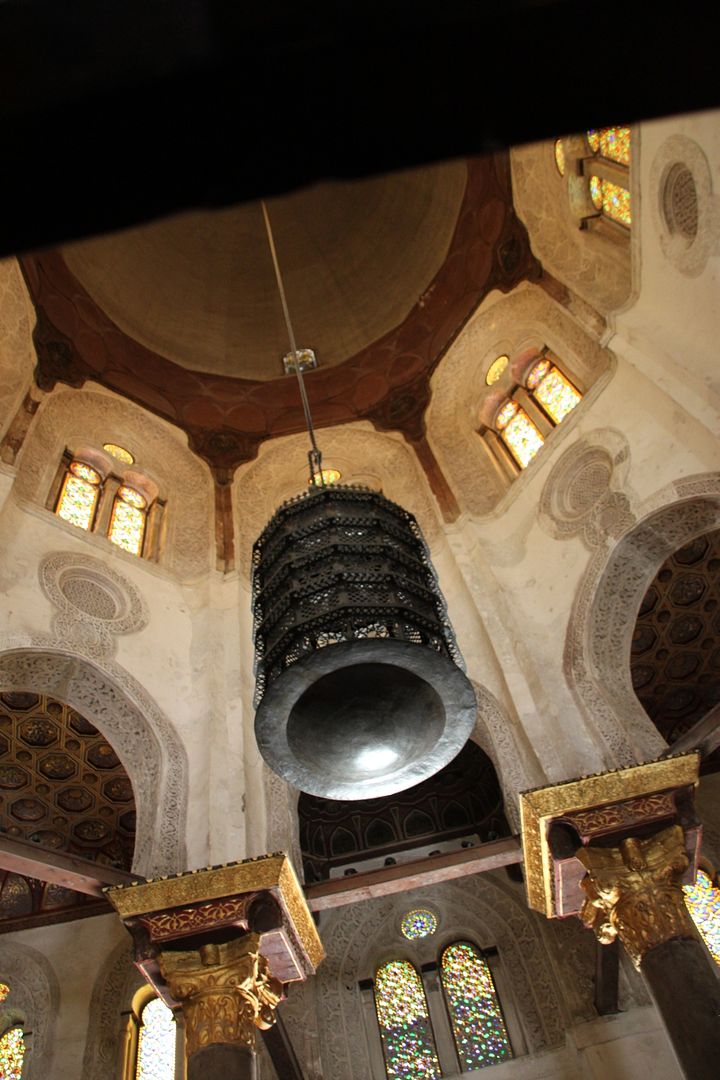
The tall pillars make the building look even taller. The lamp above the grave is a masterpiece of the lamp maker’s art.
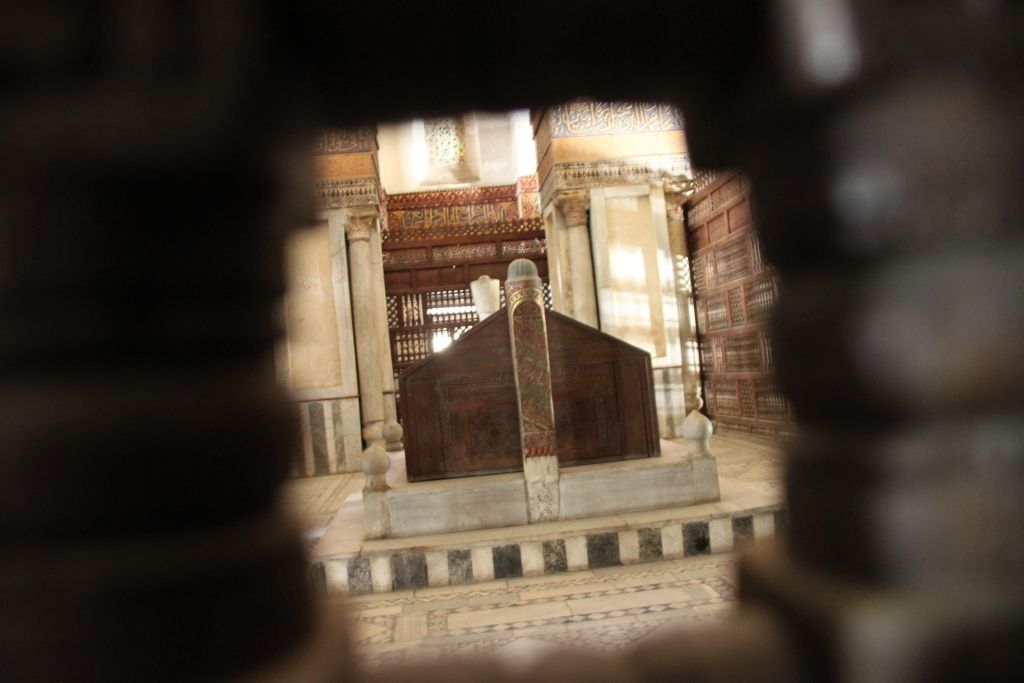
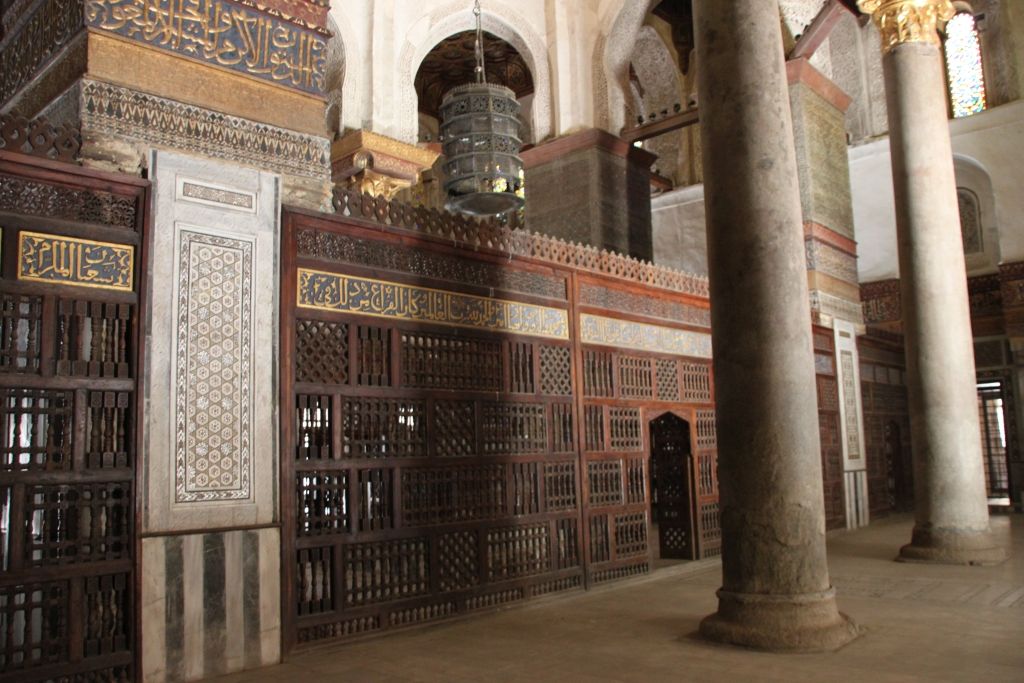
Here is the grave of the Sultan’s daughter Fatima, who is buried in this mausoleum. Very nice airy grave, with a highly carved wooden fence around it.

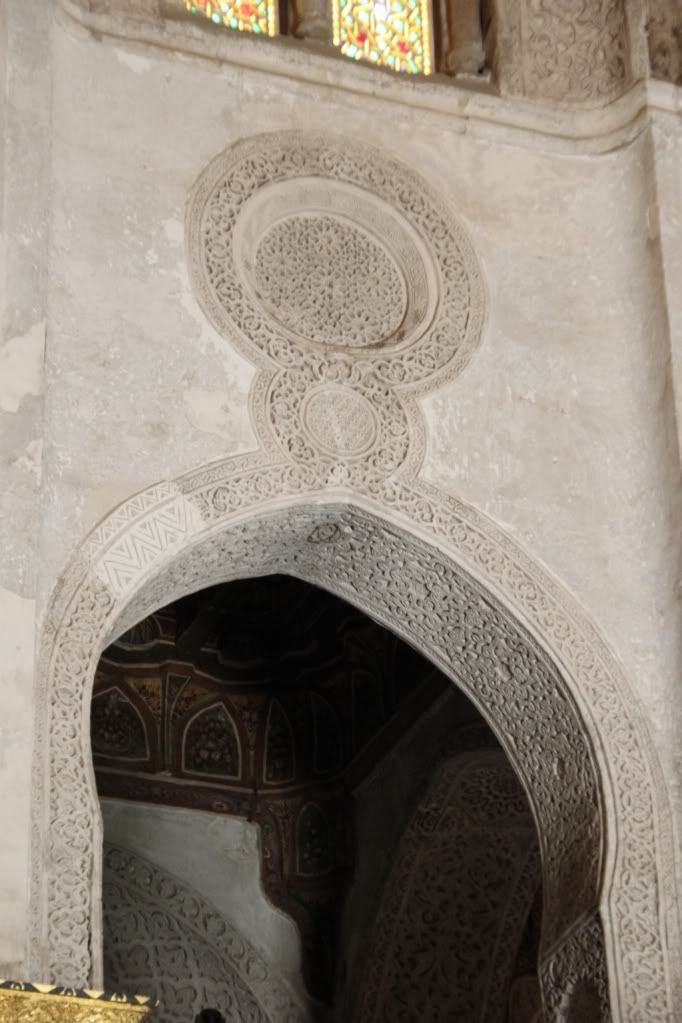
The style of the windows and the arched doors are similar.

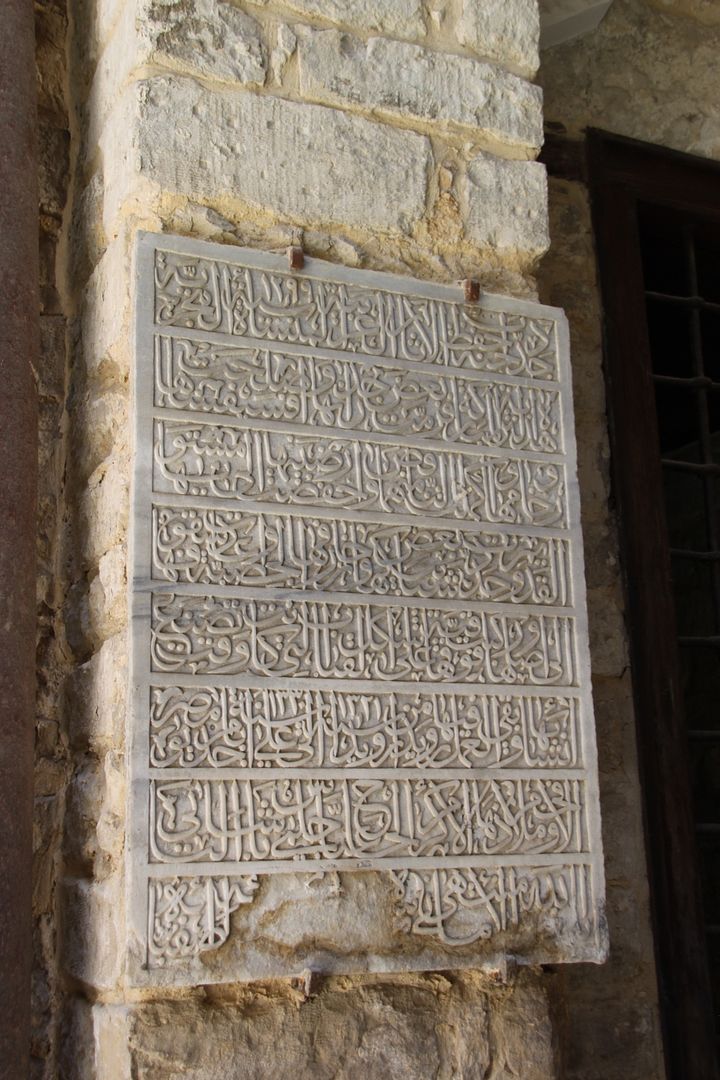
An example of a highly fluted highly polished and highly beautiful column with a decorated top. On the right, i saw this highly carved marble plaque with rows of Arabic writing carved into the surface. I am presuming that its some kind of religious text.
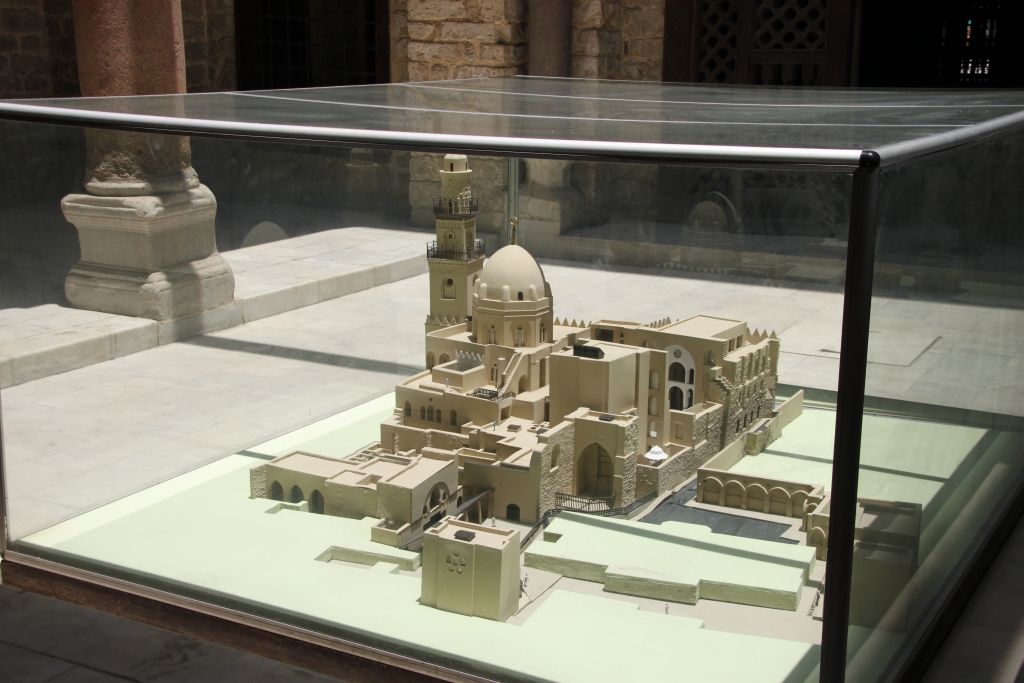
As you come out of the mausoleum, you seen this extraordinary model of the entire complex. Beautiful work and then you can actually see the entire set of buildings. Pretty big place, but understandable when you consider that there were hundreds of students here along with their teachers.
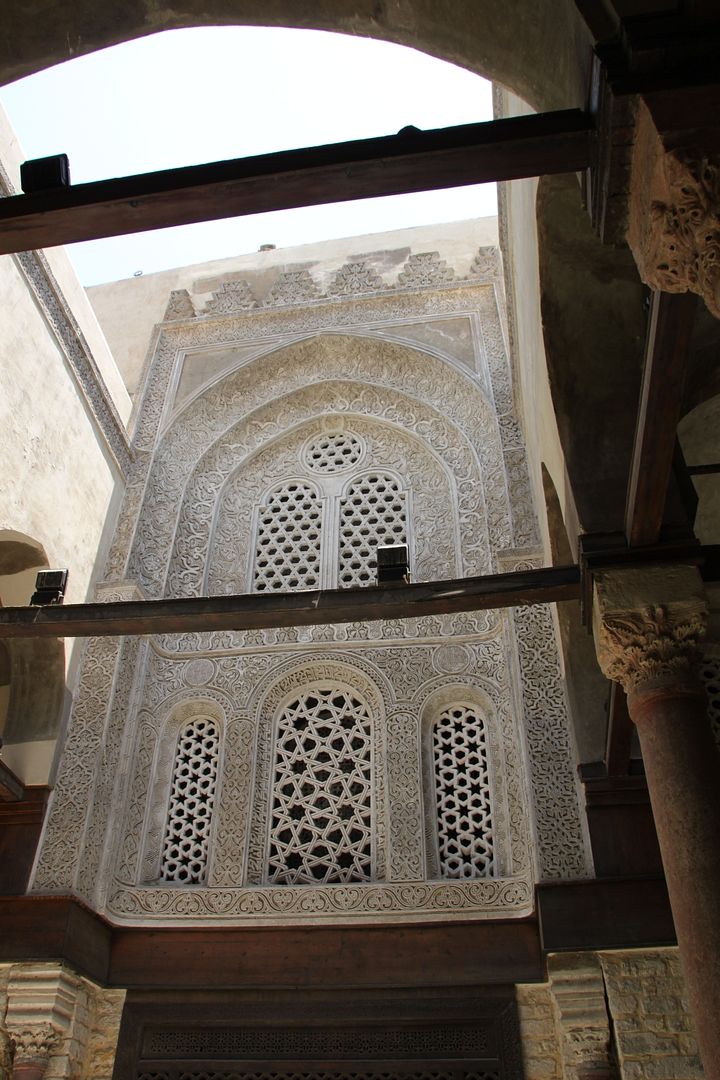
A lovely highly carved marble window.

Crossing over to the madrassah and looking back down the long corridor to the outside. The staircase in the middle is the entrance to the mausoleum.
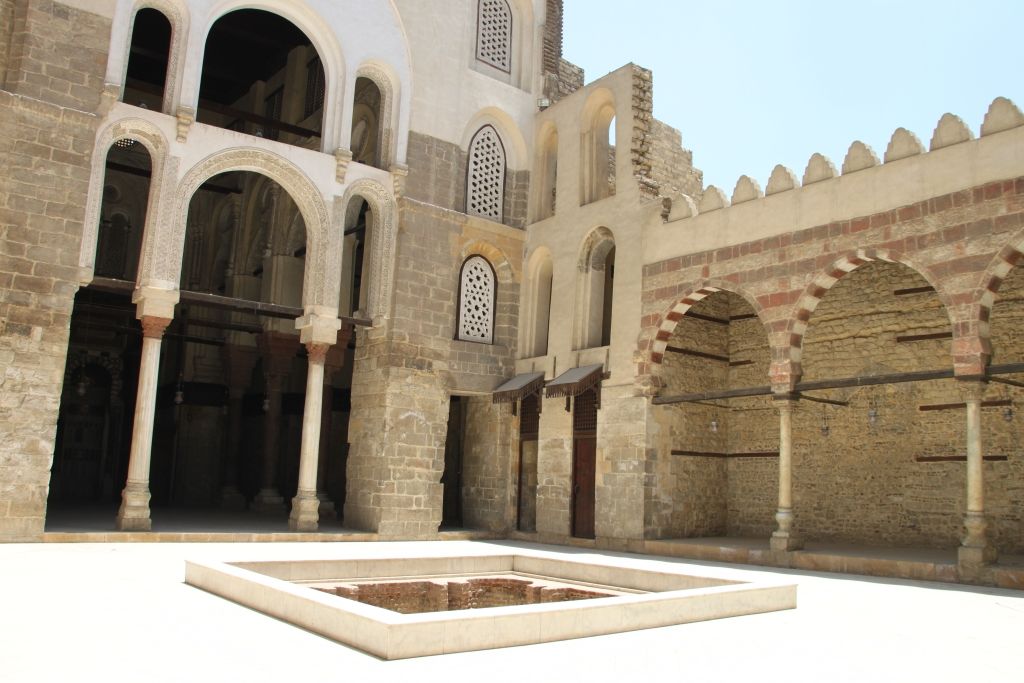
Here is the mosque with a fountain (sadly non functional) in the middle.
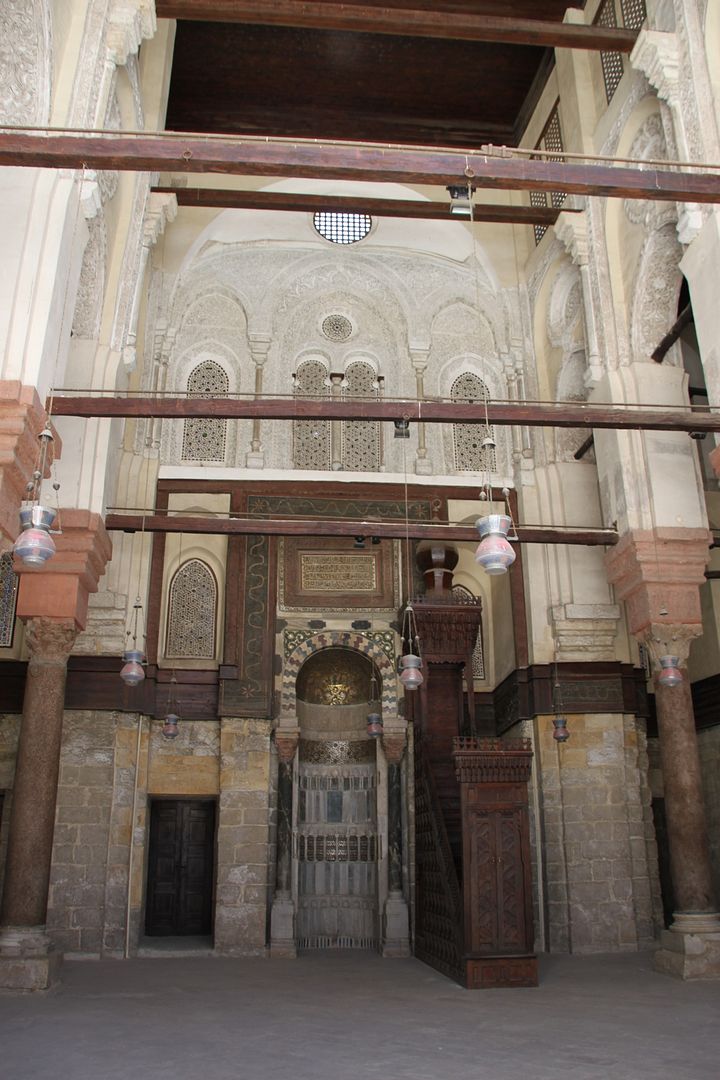
The mosque proper with the minrab on the right.

Another beautifully highly carved top of a gate.


Gilded and highly decorated domes, with columns.
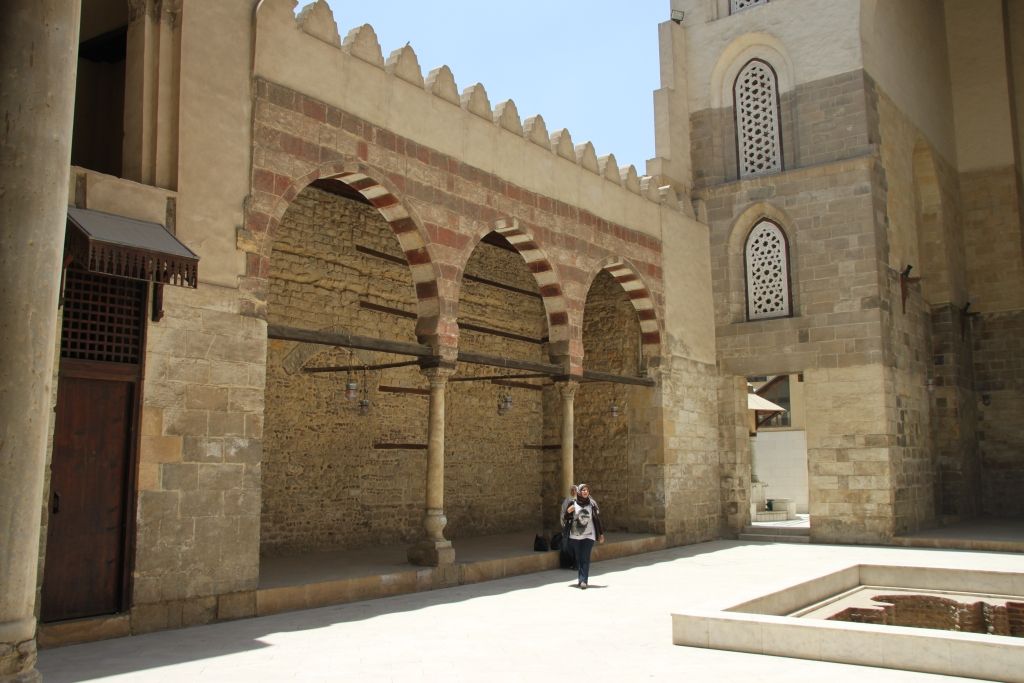
Looking back at the side areas of the mosque/madrassah, this is where students would sit and learn. The far door is an entrance to the living quarters of the students.
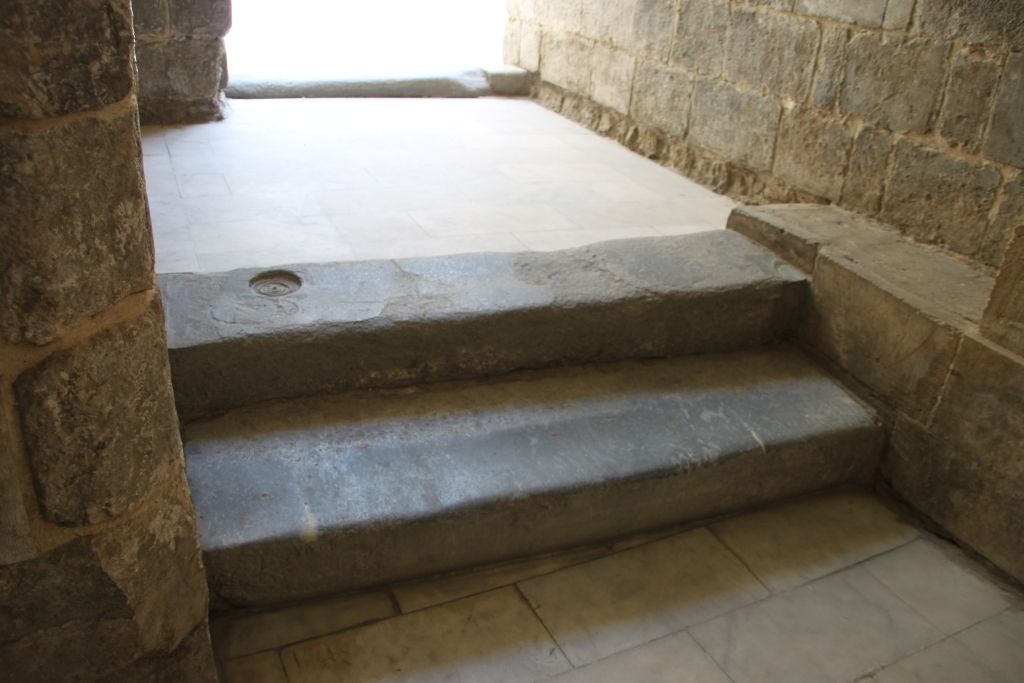
The severely worn steps leading into the mosque, so many feet would have trod these stairs, so many shuffling up to pray to God to answer their prayers and be good men.

There are lovely ironmongery on the windows, and this kind of fine symetrical work was done way back without modern equipment. Beautiful. Here is the slideshow with many other photographs and with higher resolutions.

A reasonably un-prepossessing building entrance, the first time on this street that i have seen this kind of striped stone work which is not just simple plain stripes, but nicely carved in complex shapes.

The minaret is imposing, octagonal in construction with lovely cute little spiral carved pillars. There are three balconies with exquisitely carved railings.



The facade is unusually severe but has these windows high up. Interestingly enough, the windows are of stained coloured glass, but more of that later.


Very tall open bronze doors with geometrically designs on them. There is a very long corridor with a fascinating ceiling with lovely dark ancient wooden beams.

The corridor divides the complex into two, on the right, you can peek through heavily barred windows into the mausoleum.

The mausoleum is an extraordinary building. It is much higher than its width, which gives a very very strange outlook when you walk in. Plus to complicate matters even more, it has huge thick pillars. And then on top of it, the entire inside of the mausoleum is very richly decorated in vertical and horizontal stripes as we will see, which makes the building look even taller.

The ceiling is very richly decorated. With octagonal recesses, gilded. I am sure when this was lit by lamp lights and candles, it would be a magical place.


The tall pillars make the building look even taller. The lamp above the grave is a masterpiece of the lamp maker’s art.


Here is the grave of the Sultan’s daughter Fatima, who is buried in this mausoleum. Very nice airy grave, with a highly carved wooden fence around it.


The style of the windows and the arched doors are similar.


An example of a highly fluted highly polished and highly beautiful column with a decorated top. On the right, i saw this highly carved marble plaque with rows of Arabic writing carved into the surface. I am presuming that its some kind of religious text.

As you come out of the mausoleum, you seen this extraordinary model of the entire complex. Beautiful work and then you can actually see the entire set of buildings. Pretty big place, but understandable when you consider that there were hundreds of students here along with their teachers.

A lovely highly carved marble window.

Crossing over to the madrassah and looking back down the long corridor to the outside. The staircase in the middle is the entrance to the mausoleum.

Here is the mosque with a fountain (sadly non functional) in the middle.

The mosque proper with the minrab on the right.

Another beautifully highly carved top of a gate.


Gilded and highly decorated domes, with columns.

Looking back at the side areas of the mosque/madrassah, this is where students would sit and learn. The far door is an entrance to the living quarters of the students.

The severely worn steps leading into the mosque, so many feet would have trod these stairs, so many shuffling up to pray to God to answer their prayers and be good men.

There are lovely ironmongery on the windows, and this kind of fine symetrical work was done way back without modern equipment. Beautiful. Here is the slideshow with many other photographs and with higher resolutions.
Dr. Bhaskar Dasgupta works in the city of London in various capacities in the financial sector. He has worked and travelled widely around the world. The articles in here relate to his current studies and are strictly his opinion and do not reflect the position of his past or current employer(s). If you do want to blame somebody, then blame my sister and editor, she is responsible for everything, the ideas, the writing, the quotes, the drive, the israeli-palestinian crisis, global warming, the ozone layer depletion and the argentinian debt crisis.
Friday, September 17, 2010
Traveler's Checks & Credit Cards in Egypt?
Information using ATM's, Credit Cards & exchanging $$$$ while in Egypt
Traveler's Checks & Credit Cards in Egypt? in Frommers.com Egypt Forums
Traveler's Checks & Credit Cards in Egypt? in Frommers.com Egypt Forums
Wednesday, September 8, 2010
Air Arabia (Morocco) to start operations between Casablanca and Alexandria | Al Bawaba
Air Arabia (Morocco) to start operations between Casablanca and Alexandria | Al Bawaba: Air Arabia (Morocco) to start operations between Casablanca and Alexandria
Click Here!
Air Arabia (Morocco) to start operations between Casablanca and Alexandria
Published September 7th, 2010 - 09:38 GMT
Air Arabia announced today that it will start direct services to the Egyptian city of Alexandria, from the carrier's second hub in Mohamed V Airport, Casablanca. Egypt represents the 12th destination on the Air Arabia's growing network from Morocco. The airline will start its flights to Alexandria on October 4th, 2010.
Roundtrip flights will initially operate three times per week flying to Alexandria every Tuesday, Thursday and Saturday. On October 31st, flights will operate four times per week every Monday, Tuesday, Thursday and Saturday departing Casablanca at 15:00 PM arriving in Alexandria at 21:40 PM. Return flights will depart Alexandria at 22:25 PM arriving in Casablanca at 02:00 AM. The new Alexandria– Casablanca route will also connect with Air Arabia (Maroc) network, especially to Europe.
Mr. Adel Ali, Group Chief Executive Officer said: 'We are delighted to announce the start of our flights to Alexandria. In one year since the start of Air Arabia (Maroc) operations, we have been able to organically grow our destination map and fleet. We are confident the new services between Casablanca and Alexandria will offer customers a great value for money to travel between the two cities.'
Air Arabia launched operations from its second hub in Casablanca, Morocco in April 29th, 2009. The airline currently serves direct flights from its base in Casablanca to the cities of Montpellier, Brussels, Paris, Lyon, Istanbul, Milan, Barcelona, Amsterdam, Bologna, Basel and Venezia.
Air Arabia fleet consists of brand new Airbus A320 aircraft offering its passengers best economy configuration in the market with 32' seat pitch as well as all inclusive free baggage allowance. The carrier offers customers comfort, reliability, and value for money air travel from and into The Moroccan city of Casablanca.
Click Here!
Air Arabia (Morocco) to start operations between Casablanca and Alexandria
Published September 7th, 2010 - 09:38 GMT
Air Arabia announced today that it will start direct services to the Egyptian city of Alexandria, from the carrier's second hub in Mohamed V Airport, Casablanca. Egypt represents the 12th destination on the Air Arabia's growing network from Morocco. The airline will start its flights to Alexandria on October 4th, 2010.
Roundtrip flights will initially operate three times per week flying to Alexandria every Tuesday, Thursday and Saturday. On October 31st, flights will operate four times per week every Monday, Tuesday, Thursday and Saturday departing Casablanca at 15:00 PM arriving in Alexandria at 21:40 PM. Return flights will depart Alexandria at 22:25 PM arriving in Casablanca at 02:00 AM. The new Alexandria– Casablanca route will also connect with Air Arabia (Maroc) network, especially to Europe.
Mr. Adel Ali, Group Chief Executive Officer said: 'We are delighted to announce the start of our flights to Alexandria. In one year since the start of Air Arabia (Maroc) operations, we have been able to organically grow our destination map and fleet. We are confident the new services between Casablanca and Alexandria will offer customers a great value for money to travel between the two cities.'
Air Arabia launched operations from its second hub in Casablanca, Morocco in April 29th, 2009. The airline currently serves direct flights from its base in Casablanca to the cities of Montpellier, Brussels, Paris, Lyon, Istanbul, Milan, Barcelona, Amsterdam, Bologna, Basel and Venezia.
Air Arabia fleet consists of brand new Airbus A320 aircraft offering its passengers best economy configuration in the market with 32' seat pitch as well as all inclusive free baggage allowance. The carrier offers customers comfort, reliability, and value for money air travel from and into The Moroccan city of Casablanca.
Saturday, August 28, 2010
Egypt picks site for First Nucler power plant
CAIRO (Reuters) -- Egypt has picked a site on the Mediterranean coast for its first nuclear power plant, part of a plan by the Arab world’s most populous state to shift away from oil and gas, the official news agency Mena said on Wednesday.
Egypt, which aims to start an international bidding process for its first plant this year, plans several nuclear plants and last year signed a deal with Australia’s WorleyParsons for a nuclear power consultancy. President Hosni Mubarak gave his seal of approval to the Dabaa site on the country’s north coast, Mena reported, after Electricity Minister Hassan Younes had earlier said studies concluded that the location was the most suitable.
Officials say Egypt’s combined oil and gas reserves will last roughly three decades, encouraging a shift to alternative energy sources, including nuclear and solar. Egypt already has wind farms in operation on its eastern Red Sea coast.
Egypt aims to set up four nuclear plants by 2025, with the first to start operating in 2019.
The nuclear program could add capacity of up to 4,000 megawatts (MW) by 2025, officials say. Egypt now has installed capacity of about 23,500 MW, but is straining to meet demand during an unusually hot summer, leading to intermittent power cuts across the grid. Egypt has said it aims to add an additional 58,000 MW of capacity to the grid by 2027.
Camels, interesting
Umm Sayhun, Jordan
I wanted to speak for just a moment on the scale of camels. Simply put, they're massive.I think most folks don't realize just how large a camel really is. I'm not a petite fellow, and the camels in use around Petra utterly tower above me. I'm generally lucky to come up to the base of their tails.
The average fully grown Arabian camel stands 6ft 1in (1.85m) at the shoulder and 7ft 1in (2.15m) at the hump. The hump rises about 30 inches out of its body.
Camels can run at up to 40 mph in short bursts and sustain speeds of up to 25 mph. Most have a life expectancy of approximately 40 to 50 years.
While researching the misbaha (a string of prayer beads that come in sets of 33 or 99) that I've seen some of the Bedouin men and women carrying around with them, I happened upon this quote in a photo caption:
Muslims believe that there are 99 known names for Allah, which are contemplated while carrying the beads. As the myth goes, only the camel knows the 100th name, and for this reason he is always smiling.
Friday, August 27, 2010
Morocco’s airports handle record 1.6 million passengers in July; passenger numbers up 15% in first seven months
Morocco’s airports handle record 1.6 million passengers in July; passenger numbers up 15% in first seven months
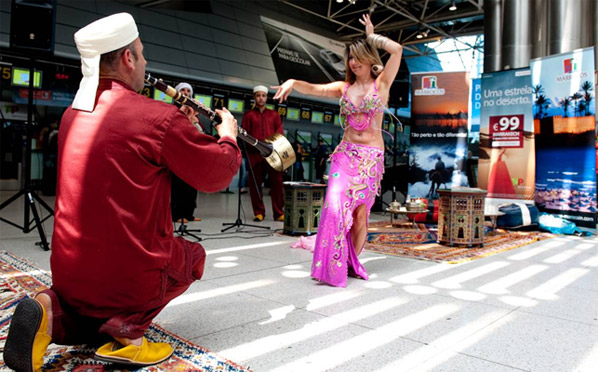
TAP Portugal has taken advantage of the growing Moroccan market and launched a route between Lisbon and Marrakech in June. The strongest growth has, however, been recorded in Fez, Nador and Tangier where Ryanair and Spanair have launched routes this spring.
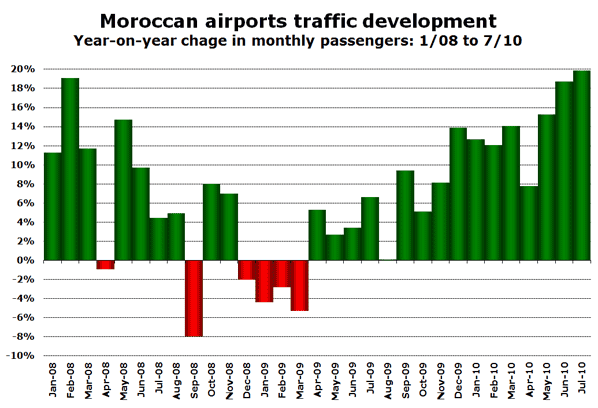
Source: ONDA
July demand reaches all-time high
Last month, Morocco’s airports handled a record 1,587,234 passengers up almost 20% on last July, and beating the previous record set last August of under 1.4 million.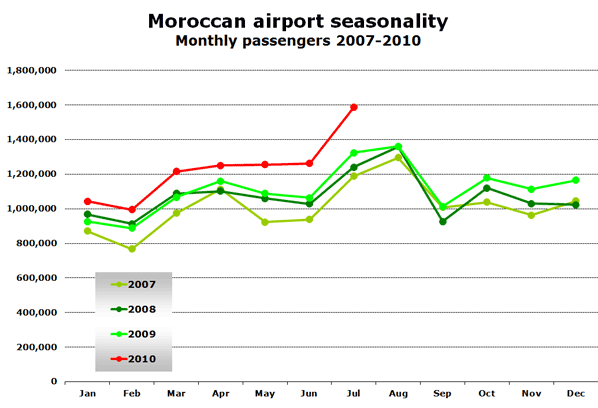
Thursday, August 26, 2010
Collection of Images in Petra
Sunday, August 22, 2010
Mahmoud Khalil's museum Statue of Cupid smashed
It seems that there is a curse in the Mahmoud Khalil’s museum because today a historical statue for Cupid at the garden was smashed in to pieces right after the visit of the public persecutor Abdel Magid Mahmoud !!
This happened in less than 24 hours of the Van Gogh’s painting theft !!
This Cupid statue’s value was estimated by millions too considering its history !! Already I do not know what it was doing at the garden when it was supposed to be inside according to those who working at the museum.
Abdel Magid Mahmoud , the public persecutor visited the museum today and he found out the 27 cameras and alarm devices in the museum are and were all broken during the crime !!
He found out that there are 7 guards only protecting this big museum with multimillion treasures and those guards are not capable of protecting anything at all !!
Mahmoud has banned the head of the arts section Mohsen Shalaan and other 8 employees at the museum from travel till the end of the investigation. There is no doubt that those who stole it had some help from inside , the canvas was cut from inside the frame for God sake , this needs time !!
Shalaan accused minister Farouk Hosni of neglecting the museum for more than a decade and that the surveillance cameras were broken for the last 15 years.
Most people are sure that Hosni will get away from this scandal as he always does.
This happened in less than 24 hours of the Van Gogh’s painting theft !!
 |
| Broken Cupid (Youm7) |
 |
| Mahmoud at the museum (Getty) |
He found out that there are 7 guards only protecting this big museum with multimillion treasures and those guards are not capable of protecting anything at all !!
Mahmoud has banned the head of the arts section Mohsen Shalaan and other 8 employees at the museum from travel till the end of the investigation. There is no doubt that those who stole it had some help from inside , the canvas was cut from inside the frame for God sake , this needs time !!
Shalaan accused minister Farouk Hosni of neglecting the museum for more than a decade and that the surveillance cameras were broken for the last 15 years.
Most people are sure that Hosni will get away from this scandal as he always does.
Updated #1
- Here is a video shot in the museum from a year ago based on the date of its upload , this video shows the level of neglect in the museum , already I assume that this video was shot by a mobile phone without a permission from the administration !! You can watch it after the break
- By the way Youm 7 published this video as if it were their exclusive finding with no credit to the one who filmed , in fact they re-uploaded again to their account !!!
- During my search in Youtube I found a clip showing the museum before the theft.
Subscribe to:
Posts (Atom)















